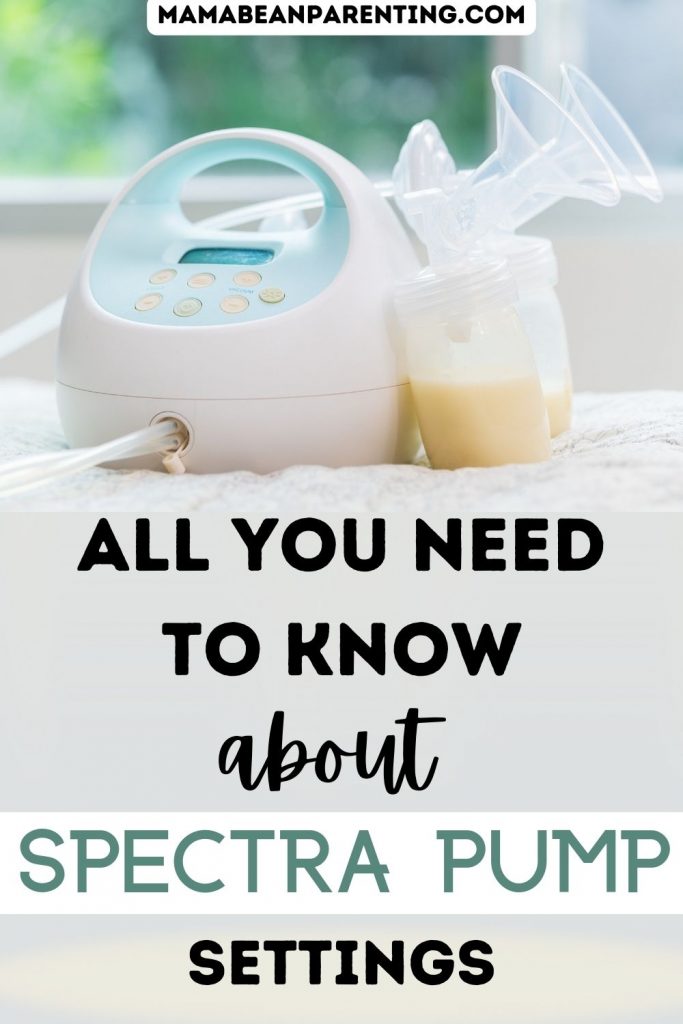There are lots of things that are confusing to new moms, and one of them is related to spectra pump settings.
I assume you just acquired the Spectra S1, Spectra S2, or Spectra Synergy, and you’ve been observing spectra pump settings and wondering, “What am I seeing?”.
Don’t worry!
You are definitely not the only one! Most breastfeeding moms had the same reaction when they were looking at the spectra pump settings.
In my articles, I always try to provide you with some valuable tips to help you get your facts straight concerning many things.
Well, that’s precisely what I’m about to do today with spectra pump settings!
I’m about to write down a cheat sheet for the Spectra pump settings, and these are also spectra settings for most milk that you can employ while pumping.
Below you’ll see four different spectra pump settings options to utilize during your first pump session with Spectra.
So let’s begin with the first pump settings option!
Once you’re over with the first pumping session, feel free to try out one of the 3 spectra pump settings options below to see which spectra pump setting is most suitable for you.
Spectra Settings for the Most Milk

These Spectra settings for most milk are a great option for starters. So I advise you to begin with these spectra pump settings and as time goes by, adjust them to the level that you’re most comfortable with.
Just please keep in mind that pumping is not supposed to be painful in any way. Hence if you notice any pain while pumping, make sure to lower the vacuum level.
Spectra Pump Settings No.1
Begin with Letdown Mode on Cycle 70 and then Vacuum Level 3 for the first two to three minutes. And then, you can utilize Cycle 54 and Vacuum Level 5 for the next five minutes.
For the next two to three minutes, go back to Cycle 70 and Vacuum Level 3 or 4.
Employ Cycle 46 and Vacuum Level 6 for the next five minutes and then you should spend around three minutes on Cycle 70 and Vacuum Level 4 or 5.
For the next five minutes, you need to use Cycle 42 and Vacuum Level 6 or 7 and then for the last five minutes, utilize Cycle 38 and Vacuum Level 7 or 8.
In terms of spectra pump settings, this is just a single spectra pump settings option. Below I will add three spectra settings options that you can utilize.
So when is the best time to use these spectra settings options?
If you ask me, you need to employ these spectra settings options for your spectra settings when:
1. You want to boost the milk supply
2. You are dealing with engorgement
3. You are utilizing the pump for colostrum
It would be great if you began with a high cycle and lower vacuum so you can encourage milk flow. Then once the milk begins to flow, you can opt for a lower cycle and higher vacuum so you can obtain the hindmilk.
If by any chance, the milk slows down or stops completely and you are no longer able to see huge amounts of milk coming out, then it would be wise to repeat everything.
Go back to the letdown button once again. Once the milk starts pouring again, then you can toggle back to the lower cycle and higher vacuum.
Let’s Discuss Spectra Settings for Spectra S2, Spectra S1, and Spectra Synergy
So how do these spectra settings work?
Namely, all of these spectra settings are going to work perfectly for every single Spectra pump. Just bear in mind that Spectra settings S2 are practically the same as Spectra settings S3.
How come?
Well, these Spectra settings are no different because they are almost the same pump.
The most significant difference between the S1 and the S2 is the fact that the S1 comes with a rechargeable battery, which is not the case with S2. And that’s about it!
This simply means that you will have to plug the S2 into your wall to function. Even though I do know some breastfeeding moms that have used Spectra S2 before, once they purchased the rechargeable battery, their lives were drastically simplified.
So what is the main difference between S1, S2, and Spectra Synergy?
Well, the biggest one is the fact that you will come across two motors on the Synergy and the vacuum level is different on both sides.
If you’re searching for the pump settings for Spectra Synergy, then you should begin with the settings that go beyond.
The cycle is going to be the same while pumping. And then you can adjust the vacuum level on both sides.
For instance, one way to do this is that one side has a higher level of suction (referring to level 8) and you may receive more milk on the other side with a lower level of suction (which is level 5).
One thing I would like to add (because this advice might just come in handy) is that you can buy a hands-free pumping bra to streamline this whole pumping process.
Not to mention the fact that it’s going to enable you to multitask.
But bear in mind that not every pumping bra works properly with the Spectra flanges since they are all one piece.
In order to find the best one, you must try out different ones. I know this can be a bit time-consuming, but once you hunt down the right one, you’ll feel instant relief.
How to Properly Employ Pump Settings (Cycle and Vacuum)

If you want to utilize the Spectra breast pump correctly, then you should pay attention to the two buttons for settings.
The first one is the cycle button, and the second one is the vacuum level button. The cycle bottom is intended for speed suction.
You should begin pumping with the let-down mod, which is Cycle 70. To reach the let-down mode, you must push the button with 3 wavy lines.
Cycle 70 is going to stimulate the milk flow. It emulates the fast motion of a baby when it is trying to encourage the milk flow.
A higher number on the Cycle setting means that the pump is able to suck several times per minute and is much quicker.
On the flip side, a lower number on the cycle setting means that the suction is slower.
If you want to turn off the let-down mode, then you should push the button with the 3 wavy lines once again.
The Cycle is going to switch to a number between thirty-eight and fifty-four which represents the expression mode.
The other button represents the Level or Vacuum button. This button is here to control the strength of the suck.
So what’s the best level to employ?
From what I know, it would be recommendable to use the highest level, however, as I said, please be sure that it’s not painful.
If by any chance you start feeling any pain, please switch to a different level.
What may shock you is that in time, as you get further postpartum, your pain tolerance is going to be much higher (in terms of suction) than it was when you were just getting started.
Moving On to Option No. 2 to Increase the Supply
If you want to boost the milk supply, then you should definitely opt for these settings. You should pump for additional five minutes once the milk stops pouring.
Why are these five minutes essential?
Namely, they are going to remind your body that it must make more milk.
This usually means that this entire pumping session will last approximately thirty minutes, during which you’ll notice that milk starts flowing.
If you decide to pump after breastfeeding, then up to fifteen minutes is supposed to be enough. If you want to increase your milk supply, you can also go back and forth with the settings.
It would be advisable to shift between the let-down mode (cycle 70) and a slower powerful suction pattern such as cycle 46 and level 8.
If you wish to boost your milk supply, then I suggest having a protein shake daily that contains unique ingredients that will help you boost it.
There are a plethora of spectacular protein shakes for these purposes that can help you with it. Another great method that you can opt for is power pumping.
Spectra Settings Option No.3 for Engorgement
If you decide to utilize the Spectra pump for engorgement, I’ll tell you precisely what you should do.
If you want to mitigate the engorgement, then you can try a lower cycle and higher vacuum.
Ask yourself if you are engorged because your milk supply is coming in or because of the clogged milk duct.
If you’re dealing with a clogged milk duct, you may try to pump as often as you can until the clog is pulled out. This will for sure provide you with some relief.
At times, maybe you will have to pump every hour.
A lot of seasoned breastfeeding mommies have told me that heated massagers have helped them to alleviate engorgement and clogged milk ducts, which is undoubtedly great news!
Plus, they can also help you pump your milk quicker.
Option No. 4 – Spectra Pump Settings for Colostrum

If you’re pumping for colostrum, you are most likely pumping right after delivery to help your milk come in quicker for your baby.
You do not need to pump for too long. Up to fifteen minutes will suffice if you want to express colostrum.
Keep in mind that colostrum can be very thick, and it can oftentimes be very difficult to get out by using an electric pump.
What frequently occurs is that you cannot get anything or only a couple of drops of colostrum when you are trying to pump and remove it right after giving birth.
So all you have to do is to begin massaging for five minutes and then opt for hand expressing. This will allow you to pump the most colostrum for your baby.
Once you’re done with all of this, you can turn to your Spectra pump.
Now, if you want to harvest colostrum before delivery, remember that something like this can cause labor.
That’s why it would be best to talk to your physician to see if you should do it before giving birth.
What are Each of the Breast Pump Parts, What Do They Do, and How to Compile Them?
The Spectra S1 and S2 pump contains:
1. Flanges – This represents the part that you can put on your breast and is also known as breast horns or breast shields.
Spectra pumps normally consist of 24mm and 28mm flanges. If you notice that pumping has become very unpleasant or painful then you must opt for a different size.
On their Spectra Baby site, you can stumble upon 20mm and 32mm breast shields. On the other hand, f you would like to try out different sizes, then make sure to go straight to Amazon.
Out there, you will run into popular brands, such as Maymom and Nenesupply.
2. Duckbill Valves – The main purpose of the valves is to make the suction that pulls milk from the breasts by stretching and releasing every single time the pump motor pulls at them.
3. Backflow Protectors – This silicone diaphragm is here to prevent the milk from flowing back into the tubing.
4. Tubing – The breast pump parts are linked to the pump motor through tubing
5. Bottles – As you pump, you’ll notice milk flowing into the attached bottles. A vast majority of wide-mouth bottles perfectly fit Spectra flanges.
However, some women love to pump into Avent bottles.
To put together all your pump parts, you first must embed the duckbill valves to the underside of the flange and then screw your bottles onto the flanges.
Then, you’re supposed to compile the backflow protectors by placing the diaphragm into the base, and then placing the top into the base, and then giving it a twist to safeguard it appropriately.
Embed the backflow protector to the top of the breast shield by utilizing a twisting motion.
Then embed one end of the tubing in the backflow protector and the other one in the pump.
If you want to double pump, then you must employ both ports and tubes that are on the pump.
On the other hand, if you wish to single pump, then simply put the port cap on the port not being utilized.
How to Properly Take Care of the Spectra S1 and S2?
Let’s discuss sterilizing and cleaning. Remember that every single part (this doesn’t apply to the tubing) must be thoroughly sterilized before you start using it.
Spectra suggests that every part (not counting tubing) must be washed after every use. Be sure to put it in warm water and add some soap.
Just please be careful and ensure not to overdo it can potentially result in damage to the gear.
When it comes to flanges, bottles, and outer pieces of the backflow protectors, you can freely wash them on the top shelf of your dishwasher.
But don’t forget that you should never put the tubing in your dishwasher.
I would like to remind you that you should never sink your pump in water. If you want to keep it clean, then just simply opt for a damp rag. Don’t worry. It’s going to clean it effectively.
How Frequently Are You Supposed to Replace the Pump Parts?

Just like most things, pump parts do not last forever, and as time goes by, the suction level will not be as good as it used to be at the beginning.
It will most likely be significantly decreased. Don’t be surprised if you noticed that they are completely torn and that residue has piled up on them.
This is particularly true with exclusive pumpers because they tend to be overused. Therefore, experts suggest replacing your pump parts by relying on the following time frames:
1. Flanges: At least twice a year
2. Duckbill Valve: Every month if you pump three or more times per day. On the flip side, if you pump less than three times per day, then you can replace it every two to three months
3. Backflow Protectors: Every three months if you pump at least three times per day. Six months if you pump less than three times per day.
4. Tubing: As soon as you noticed that moisture has built up on the inside
What to Do If Spectra S1 or S2 Suddenly Stops Working?
If you’ve been using Spectra for quite some time and now you’ve noticed that it’s not working the right way, then these are the tips you can follow to see if things will change for the better:
• Check the battery to see if it’s charged, if the pump is plugged in, or that the power cord is not damaged in any way
• The next thing that you should do is to ensure that the diaphragms inside the backflow protectors are correctly installed and dry
• Check to see if the duckbill valves are not worn out or torn
But what are you supposed to do if none of these tips help?
Then it would be advisable to contact Spectra Baby customer service. I’ve heard a lot of great things about them.
Many moms have said that they are very friendly and professional. One of the best ways to do so is by sending them a message on social media.
Conclusion

I must admit that these Spectra pump settings are pervasive.
However, my main goal was to provide you with as much helpful information as possible, so you do not have to waste hours trying to figure out how these spectra settings function.
I hope that everything I wrote in this article was of enormous help, so please let me know if everything is crystal clear now when it comes to this. I’m looking forward to it!

Well, hello there!
My name is Jennifer. Besides being an orthodontist, I am a mother to 3 playful boys. In this motherhood journey, I can say I will never know everything. That’s why I always strive to read a lot, and that’s why I started writing about all the smithereens I came across so that you can have everything in one place! Enjoy and stay positive; you’ve got this!



Bottles Compatible With Spectra • Mama Bean Parenting
Friday 14th of April 2023
[…] Spectra pump settings are versatile, and you can adjust them to your personal needs. Many moms will say that the Spectra pump is a must-have product if you’re pumping. […]